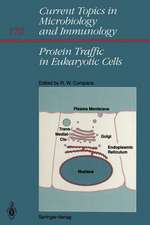The Myc/Max/Mad Transcription Factor Network: Current Topics in Microbiology and Immunology, cartea 302
Editat de Robert N. Eisenmanen Limba Engleză Hardback – 10 feb 2006
| Toate formatele și edițiile | Preț | Express |
|---|---|---|
| Paperback (1) | 1094.44 lei 6-8 săpt. | |
| Springer Berlin, Heidelberg – 23 sep 2014 | 1094.44 lei 6-8 săpt. | |
| Hardback (1) | 1098.84 lei 6-8 săpt. | |
| Springer Berlin, Heidelberg – 10 feb 2006 | 1098.84 lei 6-8 săpt. |
Din seria Current Topics in Microbiology and Immunology
- 18%
 Preț: 962.03 lei
Preț: 962.03 lei - 5%
 Preț: 1123.13 lei
Preț: 1123.13 lei - 5%
 Preț: 1085.92 lei
Preț: 1085.92 lei -
 Preț: 499.76 lei
Preț: 499.76 lei - 5%
 Preț: 967.79 lei
Preț: 967.79 lei - 18%
 Preț: 1118.62 lei
Preț: 1118.62 lei - 5%
 Preț: 717.00 lei
Preț: 717.00 lei - 5%
 Preț: 712.97 lei
Preț: 712.97 lei - 5%
 Preț: 709.51 lei
Preț: 709.51 lei - 5%
 Preț: 709.51 lei
Preț: 709.51 lei - 5%
 Preț: 721.19 lei
Preț: 721.19 lei - 5%
 Preț: 359.78 lei
Preț: 359.78 lei - 5%
 Preț: 711.88 lei
Preț: 711.88 lei - 5%
 Preț: 774.81 lei
Preț: 774.81 lei - 15%
 Preț: 640.06 lei
Preț: 640.06 lei - 5%
 Preț: 717.00 lei
Preț: 717.00 lei - 5%
 Preț: 360.34 lei
Preț: 360.34 lei - 5%
 Preț: 707.69 lei
Preț: 707.69 lei - 5%
 Preț: 717.56 lei
Preț: 717.56 lei - 5%
 Preț: 716.28 lei
Preț: 716.28 lei - 5%
 Preț: 717.20 lei
Preț: 717.20 lei - 5%
 Preț: 711.32 lei
Preț: 711.32 lei - 5%
 Preț: 711.88 lei
Preț: 711.88 lei - 5%
 Preț: 718.29 lei
Preț: 718.29 lei - 5%
 Preț: 709.51 lei
Preț: 709.51 lei - 5%
 Preț: 369.84 lei
Preț: 369.84 lei - 5%
 Preț: 712.25 lei
Preț: 712.25 lei - 5%
 Preț: 716.45 lei
Preț: 716.45 lei - 5%
 Preț: 706.60 lei
Preț: 706.60 lei - 5%
 Preț: 711.52 lei
Preț: 711.52 lei - 5%
 Preț: 713.54 lei
Preț: 713.54 lei - 5%
 Preț: 720.47 lei
Preț: 720.47 lei - 5%
 Preț: 725.42 lei
Preț: 725.42 lei - 5%
 Preț: 708.06 lei
Preț: 708.06 lei - 5%
 Preț: 713.70 lei
Preț: 713.70 lei - 5%
 Preț: 705.83 lei
Preț: 705.83 lei - 5%
 Preț: 710.96 lei
Preț: 710.96 lei - 5%
 Preț: 723.93 lei
Preț: 723.93 lei - 5%
 Preț: 707.69 lei
Preț: 707.69 lei - 5%
 Preț: 715.35 lei
Preț: 715.35 lei - 5%
 Preț: 709.87 lei
Preț: 709.87 lei - 5%
 Preț: 359.05 lei
Preț: 359.05 lei - 5%
 Preț: 374.20 lei
Preț: 374.20 lei - 15%
 Preț: 635.31 lei
Preț: 635.31 lei - 5%
 Preț: 707.86 lei
Preț: 707.86 lei - 5%
 Preț: 721.96 lei
Preț: 721.96 lei - 15%
 Preț: 632.88 lei
Preț: 632.88 lei - 15%
 Preț: 632.05 lei
Preț: 632.05 lei - 15%
 Preț: 642.83 lei
Preț: 642.83 lei
Preț: 1098.84 lei
Preț vechi: 1156.67 lei
-5% Nou
Puncte Express: 1648
Preț estimativ în valută:
210.26€ • 220.12$ • 173.98£
210.26€ • 220.12$ • 173.98£
Carte tipărită la comandă
Livrare economică 05-19 aprilie
Preluare comenzi: 021 569.72.76
Specificații
ISBN-13: 9783540239680
ISBN-10: 3540239685
Pagini: 300
Ilustrații: VII, 282 p.
Dimensiuni: 155 x 235 x 24 mm
Greutate: 0.53 kg
Ediția:2006
Editura: Springer Berlin, Heidelberg
Colecția Springer
Seria Current Topics in Microbiology and Immunology
Locul publicării:Berlin, Heidelberg, Germany
ISBN-10: 3540239685
Pagini: 300
Ilustrații: VII, 282 p.
Dimensiuni: 155 x 235 x 24 mm
Greutate: 0.53 kg
Ediția:2006
Editura: Springer Berlin, Heidelberg
Colecția Springer
Seria Current Topics in Microbiology and Immunology
Locul publicării:Berlin, Heidelberg, Germany
Public țintă
ResearchCuprins
Making Myc.- Transcriptional Activation by the Myc Oncoprotein.- Mechanisms of Transcriptional Repression by Myc.- The Mad Side of the Max Network: Antagonizing the Function of Myc and More.- Structural Aspects of Interactions Within the Myc/Max/Mad Network.- Myc Target Transcriptomes.- c-Myc, Genome Instability, and Tumorigenesis: The Devil Is in the Details.- Lessons Learned from Myc/Max/Mad Knockout Mice.- Myc/Max/Mad in Invertebrates: The Evolution of the Max Network.- The Mlx Network: Evidence for a Parallel Max-Like Transcriptional Network That Regulates Energy Metabolism.
Textul de pe ultima copertă
Intense study of the enigmatic myc proto-oncogene over the last 20 years has broadened our view of its functions and led to insights into transcriptional regulation as well as cancer etiology, cell proliferation, apoptosis, and organismal development. How can one gene be involved in so many aspects of cellular behavior? Of particular interest is the fact that the Myc protein functions as part of a network (comprising Myc, Max, and Mad proteins) whose specific interactions direct transcriptional activation or repression of a large number of target genes. The chapters in this volume examine both molecular and biological aspects of the Myc/Max/Mad network. Included are contributions concerning the regulation of its expression, the mechanisms underlying its diverse transcriptional activities, the structural bases for its critical interactions, and the nature of its target genes. Other chapters explore the evolution of the network, its role in development and genomic instability, and the evidence for a parallel transcriptional network. Overall, this volume provides a broad and current overview of research on a crucial group of transcription factors.
Caracteristici
Includes supplementary material: sn.pub/extras
















